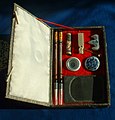Brush technique
A brush technique is a specialty in the handling of the brush in calligraphy or painting . The handling is based on a certain posture (sitting, standing) and a certain hand posture and handling of the brush. The brush technique is one of the so-called body techniques.
Calligraphy is a line technique used to represent writing. A distinction must be made between the lines and the line sequence. The lettering also depends on the paper quality and its absorbency as well as on the size and the associated volume of the brush hairs used. The handling technique associated with special brush widths, shapes and inks is of particular importance in Japanese calligraphy called Chinese and Shodō . The calligrapher's tool is called the Four Treasures of the Scholar's Room in China .
| Traditional stroke order for text written from top to bottom. |

|

|
Modern stroke order for horizontally written texts. |
In painting, too, handling, brush shape and painting material are combined to form certain brush techniques, as in pointillism , which achieves secondary color effects when using pure primary colors. The brush technique of the watercolor is particularly important , which is combined with calligraphy in East Asian art ( Chinese painting , Japanese painting ).
The painting technique, which is derived from the watercolor technique, plays a special role. B. to achieve a colored flower with just one brush movement. With the single stroke technique, even very complex images are achieved by applying an uninterrupted brushstroke.
See also
Detail from Georges Seurat : La Parade (1889).
swell
- ^ A term coined by the anthropologist Marcel Mauss in: Les techniques du corps (1934).
- ↑ To the stroke order: User: Mkill / Stroke order




